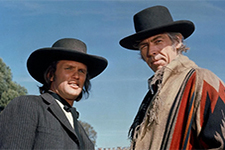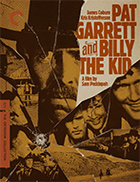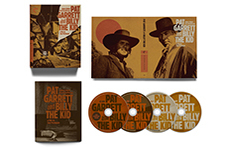Pat Garrett & Billy the Kid (4K UHD)
|  Writing about Sam Peckinpah’s final period Western, Pat Garrett & Billy the Kid, during its initial theatrical release in July 1973, Newsweek critic Paul D. Zimmerman described it as “a casualty of a prolonged shootout” between the notoriously intractable director and the equally obstinate MGM president James Aubrey. “The battle ended with Aubrey taking away Peckinpah’s ‘final cut,’” Zimmerman wrote. “And the question remains: did the studio ruin an interesting film, or did it merely try to salvage a hopelessly muddled one?” The 106-minute version that unspooled in theaters that summer was ultimately a compromise between the radically shorter version that Aubrey demanded (something in neighborhood of 80 minutes) and Peckinpah’s much grander, more idiosyncratic 122-minute version. In Zimmerman’s words, the theatrical version was “a misshapen mess,” and the question of whether that mess was a potentially great film that had been ruined or a worse mess that had been salvaged would be left unanswered for more than a decade. The opportunity to answer that question arrived on April 20, 1986, when the University of Southern California hosted a special screening of what became known as Peckinpah’s “final preview cut” at the Norris Auditorium to a packed audience. Part of the deal Peckinpah struck with MGM was that he would get to preview the film at least twice before the studio could take over, and the 122-minute version screened at USC was the last one on which Peckinpah worked directly. This print—literally the only one of its kind—had been stolen out of the MGM projection booth by co-editors Garth Craven and Sergio Ortega and actor Chalo González in order to protect it from the studio. For more than a decade it was kept hidden, moved from place to place, all but unknown and forgotten except among a small group of Peckinaph’s collaborators. Peckinpah himself passed away in 1984, thus he never got to see his original version re-evaluated. While an article in Variety suggested that “consensus among observers was that, while not a great film, it is more fullbodied, logical and coherent in the longer version,” many felt validated in their suspicion that a great film had been unfairly mangled. Critics in 1973 had recognized the flashes of brilliance and remnants of what Peckinpah was trying to achieve in the shorter, more conventional theatrical release (writing in Time, Jay Cocks argued that, “Even in the maimed state in which it has been released, Pat Garrett & Billy the Kid is the richest, most exciting American film so far this year”). The longer version made all those isolated moments cohere, revealing a larger vision that Aubrey simply couldn’t (or refused to) understand. In 2005, editor Paul Seydor, a Peckinpah enthusiast whose short documentary The Wild Bunch: An Album in Montage (1996) was nominated for an Oscar, assembled a reconstruction of Peckinpah’s intended version based on the final preview cut and various notes that suggest how he would have further refined it. And now The Criterion Collection has released the “50th Anniversary Edition,” which is a refinement of the Seydor version with additional work by Roger Spottiswoode, one of the film’s original editors who fought to preserve Peckinpah’s vision, but was blackmailed by Aubrey into collaborating on the shorter theatrical version—a devil’s bargain he has spent the rest of his career regretting. We might usefully see this new version as his penance and final opportunity to right the artistic wrongs that were committed so many decades ago. Better late than never. Watching the film again in the version that one could argue most closely approximates what Peckinpah would have released had he had the opportunity, I was struck by the balance it achieves between the harsh brutalities of life in the barely civilized wilderness of the Old West and the striving of its characters to transcend them. Like so many of his previous films, including Major Dundee (1964) and The Wild Bunch (1969), Pat Garrett & Billy the Kid is a portrait of former friends turned antagonists who are essentially mirror images of each other. It is a study in duality, a reflection of the thin line between order and chaos, the law as enforced by officially sanctioned government representatives and the law as enacted by men who hold fast to a crumbling code of honor. That there is little honor to be found in Pat Garrett & Billy the Kid—even less than in The Wild Bunch—is reflective of Peckinpah’s own philosophical, political, and professional disillusionment by this stage in his career (he intended the film to be a barely disguised commentary on the corruption of the Watergate era and its attendant corporate malfeasance). The film originated with a script by Rudy Wurlitzer, whose only other screen credits at the time were Monte Hellman’s existential cult hit Two-Lane Blacktop (1971) and the now forgotten apocalypse drama Glen and Randa (1971). There had already been dozens of Westerns about Pat Garrett and Billy the Kid, so the material offered nothing new in and of itself. Peckinpah, however, recognized the potency of the relationship between Garrett and Billy, which is a largely fictionalized conceit that fit perfectly into his recurring themes about old friends turning into antagonists as the world around them changes. As Garrett, Peckinpah cast James Coburn, whose stoic mug, flinty eyes, and gravelly voice lent the character a sense of depth and conflict and resentment. As Billy, Peckinpah took a major gamble in casting Kris Kristofferson, who was then known primarily as a folk singer with limited acting experience. With his round, unshaven face and soft eyes, Kristofferson is never fully convincing as either a psychopath or a tragic outsider. Coburn, on the other hand, is perfectly attuned to Garrett, and it is clear throughout the film that Peckinpah is infinitely more interested in his tragic arc than Billy’s. Billy the Kid must exist to motivate Garrett’s obsessive actions, and his inevitable killing of the Kid (which everyone knows is coming) is less an accomplishment than it is an acquiescence to fate. There is no resolution, which Peckinpah makes clear from the outset with a sepia prologue (cut from the theatrical version) that intercuts Garrett’s assassination in 1908 with a scene 25 years earlier with Billy and his buddies shooting chickens. Death is coming for everyone, and everything must come to an end. To reinforce that point, Peckinpah packed the screen with as many legendary Western actors as he could, many of whom he had worked with before and were near the end of their long careers. He cast Jason Robards as Governor Lew Wallace, who tasks Garrett with tracking down his old friend, and filled supporting roles with the likes of Chill Wills, R.G. Armstrong, Jack Elam, and L.Q. Jones. His greatest bit of casting was Slim Pickens as a local sheriff that Garrett brings with him on a raid. Pickens’s character gets shot in the belly, and in one of the film’s signature departures from the forward thrust of the narrative (it feels very much like a European art film in this regard), he wanders over to a lake to watch the sunset as he slowly dies. It is a beautiful, haunting, elegiac moment that is beautifully played by Pickens, made all the mournful by the subtle use of Bob Dylan’s “Knockin’ on Heaven’s Door” on the soundtrack. Dylan, who provided all of the film’s music, was also cast as an enigmatic newspaper printer named Alias who becomes one of Billy’s followers (Dylan is fine in the role, but it feels too much like stunt casting). The film was shot by John Coquillon, a British cinematographer who had previously lensed Peckinpah’s Straw Dogs (1971) and would work with him again on Cross of Iron (1977). Coquillon’s imagery vacillates between the prosaic and the lyrical, giving visual weight to the film’s balance of the gritty realities of life in the Old West and the mythic qualities Peckinpah clearly wants to evoke in his highly fictionalized (mythologized) tale. The film’s violence is harsh and graphic, as people had come to expect from “Bloody Sam,” but it never feels over the top. In fact, like The Wild Bunch and Straw Dogs, the film’s violence is meant to be reflective, to cause the viewer consternation and discomfort. It is never conventionally exciting even though it often plays by the cinematic rules of action, which is why Peckinpah frequently adds mournful codas, especially the aforementioned scene with Pickens. Although ravaged by alcoholism and a streak of self-destructiveness a mile wide, Peckinpah had enough of his artistic wits about him to produce some genuinely brilliant moments that attest to the power of his filmmaking prowess. It will always be a tragedy of both ego and malice that he was unable to bring to the screen his version of Pat Garrett & Billy the Kid, although what we have now is close enough to remind us that, when he was at his best, Peckinpah was an artist of immense power.
Copyright © 2024 James Kendrick Thoughts? E-mail James Kendrick All images copyright © The Criterion Collection | |||||||||||||||||||||||||||||
Overall Rating: 


 (3.5)
(3.5)


 This four-disc set contains three versions of the film: the 117-minute 50th Anniversary Edition on 4K UHD and Blu-ray; the 106-minute theatrical version on 4K UHD and Blu-ray; and the 122-minute final preview cut on Blu-ray.
This four-disc set contains three versions of the film: the 117-minute 50th Anniversary Edition on 4K UHD and Blu-ray; the 106-minute theatrical version on 4K UHD and Blu-ray; and the 122-minute final preview cut on Blu-ray.